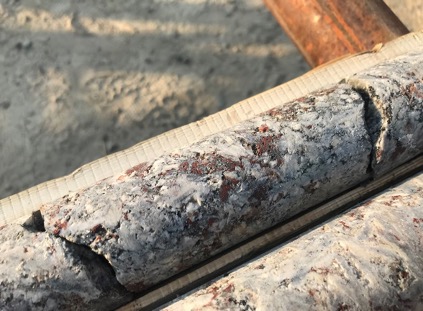MTM Critical Metals Limited (ASX:MTM) has intersected over 500m of visible REE mineralization in the first diamond drill hole completed at the Pomme REE-Nb project in Québec, Canada.
Assay results are pending and expected within approximately four to six weeks.
“We are extremely excited by the results of this first diamond drill hole. Not only has it intersected prospective carbonatite rocks but it also appears to be continuously mineralized over a 500m+ interval and based on the visual estimates may contain a number of zones containing significant REE grade,” Managing Director, Lachlan Reynolds, said.
“This hole is a vindication of our confidence that this drilling campaign at the Pomme project could have potential for making a major new rare earth element and niobium deposit discovery. We are now eagerly waiting in the results of assays and getting samples to the laboratory in Canada is a high priority. Drilling is ongoing and the second hole is underway.
“The Kintavar Exploration team managing the exploration program on-site are congratulated for delivering this excellent result, which comes only 3 months after signing the option agreement over the project.”
Diamond Drilling
A programme of diamond drilling was recently commenced at Pomme. The first drill hole of that programme, POM-23-01, was subsequently completed at a depth of 558m downhole. This hole was collared approximately 100m to the north of a historical drill hole MVX-12-01 that also intersected in excess of 500m of REE-Nb mineralization.
POM-23-01 intersected 31.75m of unconsolidated glacial sediments (till) at the top of the hole and then cored carbonatite rocks to the end of hole (EOH). The carbonatites show significant variation in lithology, including calciocarbonatite, ferrocarbonatite and silicocarbonatite (Appendix II). The carbonatites are open to depth beyond the EOH.
Visible REE Mineralization
Visible REE mineralization was observed in all rock types, in varying abundance, over the full length of carbonatite intersected in hole POM-23-01 to EOH.
The REE mineralization has been identified by the geologists on-site, who have extensive prior experience with the geology of the Montviel REE-Nb deposit located approximately seven km south of Pomme. Their observations have been routinely cross-checked using a hand-held pXRF device, which has confirmed the presence of REE’s.
The mineralization, which is tentatively identified as the fluoro-carbonate minerals cebaite (Ba3(Nd,Ce)2(CO3)5F2) and/or bastnaesite ((La,Ce,Y)CO3F), has a very distinct red colour and is easily distinguished in the drill core (see Figures 3 to 5). Monazite ((La,Ce,Nd)PO4), a brownish phosphate REE mineral, also occurs frequently in the first hole and apatite enriched in REE was locally logged within specific carbonatite layers. The mineralization occurs as medium to coarse-grained disseminations and blebs allowing the geologists to make a subjective estimate of the REE grade
Mineralization was locally logged with up to 20% visual abundance in the drill core, though typically ranged from 1% to 5% abundance over decimetre to metre scales. A number of
zones from 10m to 20m thickness (downhole length) were estimated to contain “medium grade” REE oxide, considered to be approximately 0.5% to 1% total rare earth element (TREO) content.
Further Work
Drilling is continuing at Pomme and the drill rig has mobilized to the second hole of the program, located approximately 500m to the north of POM-23-01 (Figure 2).
Geological logging and sampling of the drill core from POM-23-01 is currently underway. Samples will be transferred to a sample preparation facility in the city of Val d’Or in due course. Detailed assay results are expected to be available in four to six weeks depending on laboratory turnaround times.
A total of 10 holes for approximately 5,000m of drilling are planned as a first-pass test of the Pomme carbonatite complex and the REE-Nb mineralization.
For further information please visit: https://mtmcriticalmetals.com.au/










